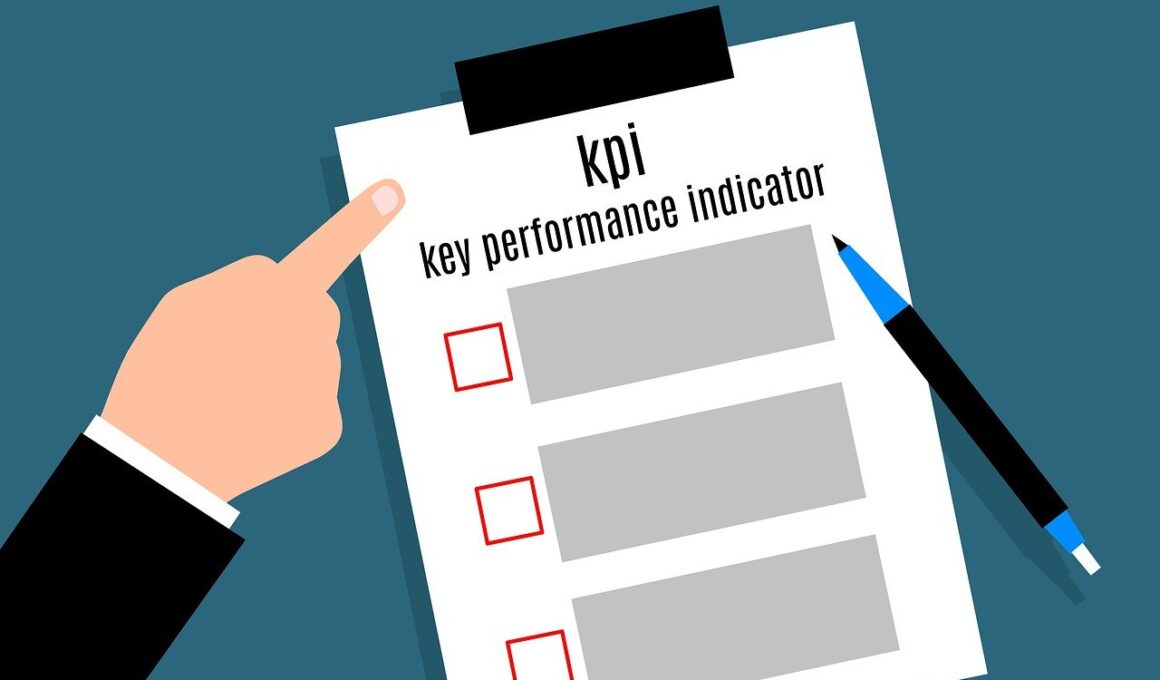Balancing Individual and Team Performance Metrics in Cross-Functional Settings
In today’s dynamic business environment, effective performance management is crucial for the success of cross-functional teams. These teams often consist of members from various departments, each bringing diverse skills and perspectives. Striking a balance between individual and team performance metrics is essential. Individual metrics assess personal contributions, while team metrics gauge collaborative efforts. This dual focus fosters accountability and reinforces collective goals. For organizations to thrive, performance management systems must integrate these metrics harmoniously. This requires establishing clear communication channels to ensure expectations are understood by all team members. Effective collaboration hinges on transparency, which paves the way for all parties to remain aligned. There are also psychological aspects to consider; individuals perform better when they feel their contributions are valued. Setting performance benchmarks is a valuable strategy, as it provides clarity regarding desired outcomes. Team goals should be articulated in conjunction with individual targets, promoting a shared vision for success. Training programs emphasizing these elements can further enhance outcomes and ensure cohesiveness in achieving stated objectives, driving overall organizational performance upwards. Innovation and continual improvement process must be embedded in the company culture to sustain effectiveness.
Defining Clear Metrics for Success
To establish a robust framework for performance management, organizations need to define clear and measurable metrics. These metrics must be aligned with both individual and team objectives to create a cohesive approach. Specificity is key; the more defined a metric, the easier it is for members to understand what is required of them. For individual performance, metrics might include quantitative goals such as sales figures or project completion rates. For teams, success metrics could encompass overall project timelines, customer satisfaction ratings, or the successful achievement of strategic initiatives. By utilizing a balanced scorecard approach, companies can evaluate performance from different perspectives. Establishing a baseline of expectations helps provide context for evaluation. Furthermore, integrating feedback mechanisms allows for ongoing adjustments and developments based on performance data. This iterative approach means that metrics can evolve, ensuring their continued relevance to changing business demands. Regular assessments of both individual and team performance should be conducted to track progress towards goals. By remaining flexible and adaptable, organizations can navigate challenges more effectively, driving greater success in cross-functional environments while encouraging accountability and collaboration across diverse teams.
Effective communication plays a pivotal role in balancing performance metrics across teams. When roles are clear and everyone understands how their work contributes to team objectives, it fosters a sense of belonging. Regular team meetings, feedback sessions and progress updates help maintain awareness of each individual’s role in the collective context. Communication tools, whether digital or face-to-face, should be leveraged to facilitate real-time discussions and adjustments. This clarity reduces misunderstandings and ensures all team members are aligned towards common goals. Also, feedback is essential for continuous improvement; it allows teams to celebrate successes and identify areas needing enhancement. Employing a collaborative platform for feedback can empower team members to give and receive constructive criticism. The openness creates a culture of trust, pushing individuals to strive for excellence. Moreover, embracing diverse perspectives can enhance problem-solving. Each member’s input is valuable, leading to innovative solutions. In cross-functional settings, drawing on various experiences fosters creativity. Implementing regular brainstorming sessions can be beneficial here. Utilizing these sessions allows for sharing ideas and garnering enthusiasm for collective performance. In doing so, businesses can maintain a healthy balance between individual contributions and team dynamics.
Emphasizing Team Collaboration
Team collaboration is more than just working together towards a common goal. It is integral to achieving high-level performance. Developing effective teamwork requires a focus on relationships and respect among team members. This sets the stage for honest dialogue and enhances collaboration and innovation. When cultivating effective cross-functional teams, organizations should prioritize team-building activities. Such activities strengthen personal relationships and create a foundation of trust. Furthermore, establishing clear roles minimizes conflict and enhances cooperation. While individuals may have specific metrics, the overall team goals should remain the ultimate focus. Tools like project management software can aid collaboration by clearly outlining tasks and responsibilities. Teams should regularly evaluate their collaborative processes to enhance efficiency. Another aspect to consider is celebrating achievements, both individually and collectively. Recognizing efforts boosts morale and encourages continued engagement. Acknowledgment can take many forms, from simple verbal recognition to awards or incentives. Creating an environment where success is celebrated helps maintain motivation. This way, all members realize that their contributions towards the entire team’s goals are crucial, fostering a culture of mutual support and satisfaction, which ultimately reinforces lasting performance improvements.
Moreover, coaching and mentoring are essential components in managing individual and team performances. When leaders take the time to guide their team members, they help develop skills and build confidence. Regular coaching sessions can focus on identifying personal strengths and areas for development. This personalised approach not only improves individual performance but also enhances the team’s overall capabilities. Mentoring programs can pair less experienced members with seasoned professionals, promoting knowledge transfer and growth. Such initiatives create a culture of continuous learning, which is vital in today’s ever-evolving work landscape. An emphasis on personal development aligns individual ambitions with team goals, creating synergy. Monitoring progress through one-on-one meetings can ensure everyone remains on track. Leaders should encourage an open-door policy, enabling team members to seek guidance whenever needed. This accessibility fosters communication and builds strong connections. Furthermore, it empowers individuals to take ownership of their tasks while feeling supported. Ultimately, enhancing performance management through coaching and mentoring cultivates an environment where personal and team goals are pursued simultaneously. This structure aids organizations in achieving enhanced overall performance while nurturing talent and leadership within their teams.
Utilizing Data-Driven Insights
Incorporating data-driven insights into performance management processes is increasingly crucial. By leveraging analytics, organizations can gain a deeper understanding of performance metrics and trends. Emphasizing data provides a solid foundation for informed decision-making. Performance dashboard tools enable teams to visualize individual and collective achievements clearly. These insights help identify strengths and weaknesses, fostering improvements in key areas. By using historical data to forecast future performance, businesses can set realistic targets that challenge teams while remaining attainable. A culture of continuous assessment is vital; regular evaluations ensure data remains relevant. Furthermore, data sharing improves transparency among team members. When everyone has access to the same metrics, it promotes accountability and healthy competition. It also enables teams to celebrate milestones achieved as a unit, boosting morale. Creating a centralized repository for performance data can enhance accessibility. Investing in analytics tools can provide detailed insights that inform training and development initiatives. Ultimately, a proactive approach to data utilization strengthens performance management. Organizations that embrace analytics are better positioned to thrive in cross-functional settings, leading to sustained growth and an adaptive culture conducive to innovation and excellence.
In conclusion, balancing individual and team performance metrics in a cross-functional setting is essential for organizational success. By establishing clear metrics, fostering communication, emphasizing collaboration, and utilizing data insights, organizations can create a robust performance management framework. This framework not only enables individuals to shine but also elevates the performance of teams. It requires a commitment to nurturing a culture that values both personal contributions and collective efforts. Leadership plays a critical role in this process, providing the necessary support and guidance. Continuous engagement and feedback are vital for adapting to the ever-changing business landscape. By encouraging dialogue and team-building, organizations can strengthen relationships and foster trust. This ensures that team members feel connected and aligned with shared goals. Ultimately, organizations that master this balance can effectively leverage the unique strengths of both individuals and teams. This dual focus enhances overall performance while creating an environment where innovation thrives. In doing so, cross-functional teams can not only meet their objectives but exceed expectations, driving organizational growth and success in the competitive marketplace.
Conclusion
In conclusion, balancing individual and team performance metrics in a cross-functional setting is essential for organizational success. By establishing clear metrics, fostering communication, emphasizing collaboration, and utilizing data insights, organizations can create a robust performance management framework. This framework not only enables individuals to shine but also elevates the performance of teams. It requires a commitment to nurturing a culture that values both personal contributions and collective efforts. Leadership plays a critical role in this process, providing the necessary support and guidance. Continuous engagement and feedback are vital for adapting to the ever-changing business landscape. By encouraging dialogue and team-building, organizations can strengthen relationships and foster trust. This ensures that team members feel connected and aligned with shared goals. Ultimately, organizations that master this balance can effectively leverage the unique strengths of both individuals and teams. This dual focus enhances overall performance while creating an environment where innovation thrives. In doing so, cross-functional teams can not only meet their objectives but exceed expectations, driving organizational growth and success in the competitive marketplace.


